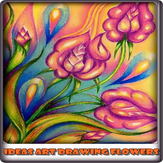
Description
During one winter season, I began drawing bouquets and realized that I really missed drawing from life. I started to experiment with my usual abstract underpaintings on paper and then drew the bouquet on top. This structure allowed me a freedom in creating abstract flowers with pastels.
I look at the flower as a source of lines, shapes, negative space, gesture, color and value. Many times, this is a way to create an abstract flower, with a variety of lines inspired by the subject in front of me or the memory of the flower. It’s another source of abstraction. I never intend on creating a representational image of the flower.
Artists have asked me how to make abstract art that features flowers. My advice is to take time to draw the flower. Look at it as you would a figure drawing. Begin by creating quick, loose gestures with a pencil (or charcoal) and paper. Look for its movement. Create simple blind contour drawings of the flower. This type of drawing has always been important to me. I find it really gets me in touch with the subject.
Sit with the flower in front of you, either outside by a garden or in your studio. Look carefully at the flower and follow the edges, contours, negative space and folds of the flower in front of you. Put your pencil on the paper, and imagine your pencil is touching the flower. As your eye moves, so does your hand. Draw slowly and don’t look at your paper. This type of drawing creates a meditative frame of mind that helps generate many creative ideas. You will also create lines that you’ll be able to use in subsequent paintings or drawings.
Use a combination of life drawing and photographs to guide your work. Manipulate the photographs in order to be more creative with your compositions and color choices. Crop, change the contrast and use a grayscale photo. Don’t be tempted to copy a photograph of a flower exactly the way you see it. I’ve used the same photograph for several of my coneflower pastels but I vary the composition and color scheme each time. Sometimes I may only use one flower and other times I may use three or five.
Change the color of the flower to suit you. I’m often inspired by certain colors and use these in both non-objective works and abstract realism. I’ve created abstractions of coneflowers in a variety of colors including blue and green. Choose colors based on emotion or personal preference. Create dark flowers or light flowers. Let your imagination take the flower into different realms. Use the flower as a symbol.
-
During one winter season, I began drawing bouquets and realized that I really missed drawing from life. I started to experiment with my usual abstract underpaintings on paper and then drew the bouquet on top. This structure allowed me a freedom in creating abstract flowers with pastels.
-
I look at the flower as a source of lines, shapes, negative space, gesture, color and value. Many times, this is a way to create an abstract flower, with a variety of lines inspired by the subject in front of me or the memory of the flower. It’s another source of abstraction. I never intend on creating a representational image of the flower.
-
Artists have asked me how to make abstract art that features flowers. My advice is to take time to draw the flower. Look at it as you would a figure drawing. Begin by creating quick, loose gestures with a pencil (or charcoal) and paper. Look for its movement. Create simple blind contour drawings of the flower. This type of drawing has always been important to me. I find it really gets me in touch with the subject.
-
Sit with the flower in front of you, either outside by a garden or in your studio. Look carefully at the flower and follow the edges, contours, negative space and folds of the flower in front of you. Put your pencil on the paper, and imagine your pencil is touching the flower. As your eye moves, so does your hand. Draw slowly and don’t look at your paper. This type of drawing creates a meditative frame of mind that helps generate many creative ideas. You will also create lines that you’ll be able to use in subsequent paintings or drawings.
-
Use a combination of life drawing and photographs to guide your work. Manipulate the photographs in order to be more creative with your compositions and color choices. Crop, change the contrast and use a grayscale photo. Don’t be tempted to copy a photograph of a flower exactly the way you see it. I’ve used the same photograph for several of my coneflower pastels but I vary the composition and color scheme each time. Sometimes I may only use one flower and other times I may use three or five.
-
Change the color of the flower to suit you. I’m often inspired by certain colors and use these in both non-objective works and abstract realism. I’ve created abstractions of coneflowers in a variety of colors including blue and green. Choose colors based on emotion or personal preference. Create dark flowers or light flowers. Let your imagination take the flower into different realms. Use the flower as a symbol.
